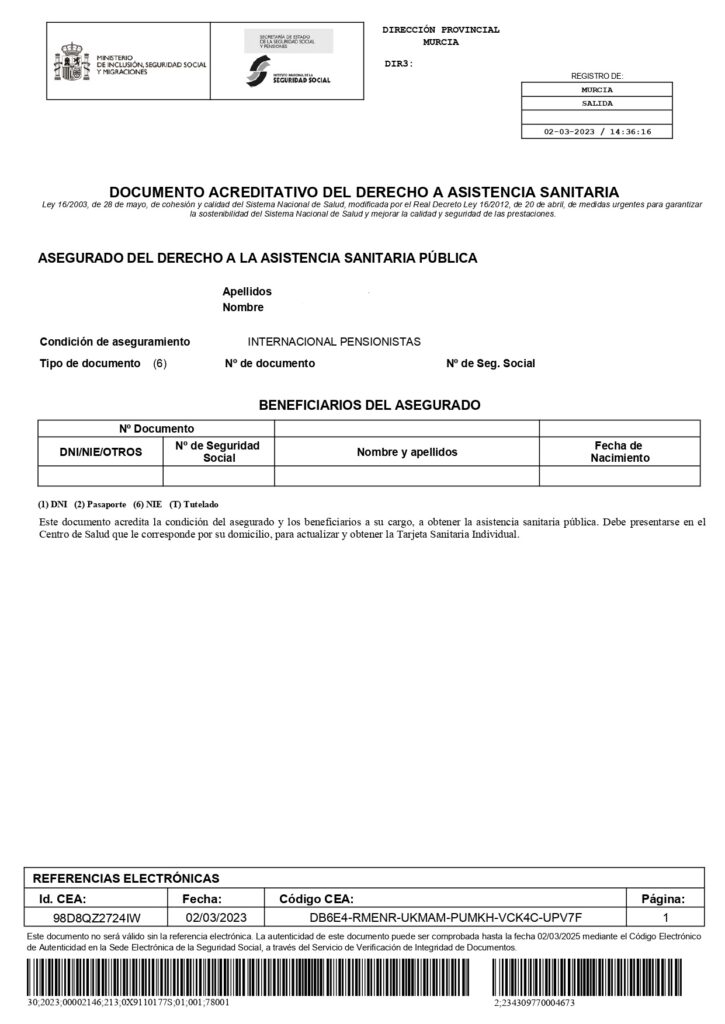A “Documento Acreditativo del Derecho de Asistencia Sanitaria” (also known as a “derecho letter”) is a document issued by the Spanish Social Security Administration (Instituto Nacional de la Seguridad Social or INSS) and certifies that the holder is entitled to medical care under the Spanish National Health System (Sistema Nacional de Salud or SNS).
How to qualify for this Certificate?
You will need to be eligible for an S1 from your home country
If you are a state pensioner and moving to Spain, you should be eligible to apply for a document called an S1. This document proves that your home country (the UK, Ireland for example) will cover you for public/state healthcare in Spain. Currently the UK still has a convenio (agreement) in place with Spain to export your healthcare rights. Once you have your S1 and residency in Spain you can apply for national healthcare and the certificate.
Can I use an S1 for a Non Lucrative Visa?
At the time of writing, yes you can, but there are a few hoops to jump through. You’ll need to complete a pre-registration process with INSS using this link and then finish off the registration once you have your visa and TIE card in Spain.
You’ll need to present proof of pre-registration of the S1 with the INSS at the Consulate when you go to your visa appointment.
Once you have your visa, the registration of the S1 can only be completed once you’ve applied for your TIE card and have a Padron certificate in place.
As part of our Non-Lucrative Visa service, Upsticks arranges all this (both pre-registration and completion) on behalf of our clients.

What do I do once I have the DOCUMENTO ACREDITATIVO DEL DERECHO DE ASISTENCIA SANITARIA?
Once you have your derecho letter/certificate, you’ll need to register at your local public healthcare centre (Centro de Salud) where you’ll be allocated a doctor. To do this, you’ll need to take the following documents with you:
- Passport
- TIE card
- Padron certificate
- Your DOCUMENTO ACREDITATIVO DEL DERECHO DE ASISTENCIA SANITARIA
Depending on the region in which you are registering, you may need to fill out a form or two, so best to take a Spanish speaker with you. Once registered, you should receive your new healthcare card through the post and you’ll be issued with a document/letter which allows you to access healthcare straight away.
Click HERE for a map of all medical centres in Andalucia
Click HERE for a map of all medical centres in Murcia
Click HERE for a map of all medical centres in Alicante
If you’re not sure which local medical centre applies to your address, ask at your local Town Hall (Ayuntamiento) for the details.
How long does the whole process take?
When you arrive in Spain you won’t be able to access the public healthcare system straightaway. Once you have submitted all the right documents to complete the registration of the S1, it can still take a couple of months for Social Security to process and issue the final DOCUMENTO ACREDITATIVO DEL DERECHO DE ASISTENCIA SANITARIA certificate.
Make sure you have sufficient medication available to cover this gap and maybe even consider taking out private health insurance on a temporary basis, just until you are fully covered by the national health system.
Prescriptions
Under the Spanish national health system, patients are charged a percentage of the cost of their prescriptions, normally around 40-70% based on the medication and the patient’s income level. The cost of prescriptions in Spain can vary depending on several factors, such as the type of medicine and the province you live in. Under the S1 system, individuals may be exempt or eligible for reduced rates, depending on their circumstances.
Once you are registered with a doctor, they will complete an initial review of your health and add any prescriptions to your healthcare card. You can then reclaim this at any pharmacy, paying the reduced rate for medication if you’re eligible.
The information in this article was current on the date published.
Article last reviewed/updated 19.05.2023

